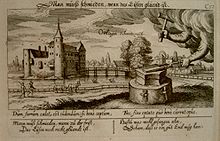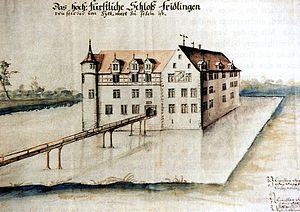Friedlingen Castle
| Friedlingen Castle | ||
|---|---|---|
| Alternative name (s): | Ötlikon Castle; Ottlingen Castle; Friedlingen Castle | |
| Creation time : | around 1311 | |
| Castle type : | Niederungsburg | |
| Conservation status: | Burgstall, no remains | |
| Standing position : | Nobles | |
| Place: | Weil am Rhein- Friedlingen | |
| Geographical location | 47 ° 35 '48 " N , 7 ° 36' 23" E | |
|
|
||
The castle Friedlingen is an Outbound Wasserburg within the boundaries of the district Friedlingen the city of Weil am Rhein in the district of Lörrach in Baden-Württemberg . Until 1650, the names Schloß Ötlikon or Ottlingen were also used for Friedlingen Castle . Nowadays one speaks more of Friedlingen Castle .
location

Friedlingen Castle was at the foot of the Leopoldshöher Rain. It was described as a paradisiacal place in the middle of a beautiful meadow landscape, surrounded by ponds and old trees. Due to its exposed border location with France and also with the city of Basel, the area around the castle has repeatedly been the scene of acts of war. Finally, the castle was the proximity to the French Vauban - Fortress Hüningen undoing the French in the 17th and 18th centuries devastating incursions took out their protection out into the Markgräflerland.
In today's cityscape of Weil am Rhein, the castle would have to be located west of Sternschanzstrasse, between Weiherweg and Lustgartenstrasse.
history
Ötlikon was first mentioned in a document in 1280 and at that time it belonged to the Landgraviate of Sausenberg - the Klingental monastery in Basel acquired goods there and was the largest landowner until its dissolution in 1559.
It is not known when and by whom the Weiherschloss was built. It was mentioned again in 1311 when it came to the Basel Knights of the Münch von Münchenstein as a fief of the Lords of Rötteln . In 1356 the palace was destroyed by the great Basel earthquake . On July 13, 1368, Konrad Münch von Münchenstein sold the castle and some localities for 1400 guilders to the Röttler Margrave Rudolf .
As mentioned by the Basel chronicler Christian Wurstisen , the castle was set on fire on August 5th, 1445 during the turmoil of the Old Zurich War . The background was a vengeance by the Basler in the Austrian Breisgau. On their return, the people of Basel set fire to the castle in which the Basel citizen Adelberg von Bärenfels , who had been expelled from the city and who, like other Basel knights, had spoken out in favor of calling the Armagnaks against the Swiss, had stayed.

In the following period the castle fell into disrepair and was not repaired until 1561, more than a hundred years later, by Michael Rappenberger, Landschreiber zu Rötteln. Then the Lords of Rotberg bought it , before it was acquired in 1640 by Margrave Friedrich V of Baden in exchange for the village of Hertingen . The castle did not survive the Thirty Years' War unscathed and therefore had to be renovated again. In memory of the Peace of Westphalia and the end of the war, the margrave renamed Ötlikon Castle in 1650 to Friedlingen Castle. This was followed by a heyday of the castle lasting around 28 years, during which it was used by the margravial family for social events such as weddings, court parties and hunts. On February 6, 1678, Friedlingen Castle was occupied and partially destroyed by French troops under Marshal François de Créquy in the course of the Dutch War . A description of the occupation that is very readable for the interested reader can be found in the chronicle of the community of Weil . In contrast to the destroyed neighboring castles of Rötteln , Sausenburg , Badenweiler or Hiltelingen, Friedlingen Castle was restored.
The new, quite stately Kammergut Friedlingen consisted of the castle, the Meierhof with residential house, courtyard, barn, stables, storage, a shepherd's house, a tree, herb and grass garden, agricultural areas and various fish ponds, as well as two Rhine islands. After the Battle of Friedlingen on October 14, 1702, the castle was destroyed and not rebuilt. After the last two remaining farms in Friedlingen were destroyed in the Polish War of Succession in 1733, Margrave Karl Friedrich decided around 1750 to sell the chamber property and its lands to various farmers and the community of Weil.
Nothing has been preserved from the former castle complex.
literature
- Max Miller (ed.): Handbook of the historical sites of Germany . Volume 6: Baden-Württemberg (= Kröner's pocket edition . Volume 276). Kröner, Stuttgart 1965, DNB 456882928 .
- Franziska Geiges-Heindl: From the beginnings of settlement to the end of the Old Kingdom , In: Weil am Rhein (editor Fred Ludwig Sepainter), Weil a. Rh. 1986, pp. 55/56
- Ludwig Keller: History of the city of Weil am Rhein . Weil am Rhein, 1961
- Bruno Rabus: Friedlingen through the ages - yesterday and today - 350 years of the Westphalian Peace Treaty and naming Friedlingen in Das Markgräflerland , Volume 2/2000. Schopheim, 2000, pp. 161–172 Digitized version of the Freiburg University Library
- Heinz Schneider, Beat Ernst: Nature and Landscape in the Basel Region , CD-Rom. Christoph Merian Verlag, Basel.
- Regesta of the Margraves of Baden and Hachberg 1050–1515 , published by the Baden Historical Commission, edited by Richard Fester , Innsbruck, Verlag Wagner 1892
- Karl Tschamber : Friedlingen and Hiltelingen. A contribution to the history of the wasteland in the Baden region , Hüningen 1900
- Adolf Poinsignon : The former Friedlingen Castle . In: Schau-ins-Land, Volume 15 (1889), pp. 78–80 Digital copy of the Freiburg University Library
Web links
- Web access to the regests of the Margraves of Baden and Hachberg 1050–1515
- Illustration by Daniel Meisner from 1625: Ottlingen. You have to forge when the Eysen is glowing ( digitized )
- Etching by Matthäus Merian on www.virtuelles-kupferstichkabinett.de
- Pen and ink drawing in the Basel State Archives
- Entry Discover the Princely Castle of Frietlingen near Basel on Landeskunde online - leobw
- Reconstruction drawing by Wolfgang Braun
- Discover the map of the hamlet of Bann with the castle (Schloss Buck) online - leobw
Individual evidence
- ↑ "Friedlingen (Ötlikon) - Rise". In: Regional information system for Baden-Württemberg. Baden-Württemberg State Archives, accessed on November 16, 2017 .
- ↑ s. Regest of the Margraves. h690
- ↑ see entry on discover regional studies online - leobw


